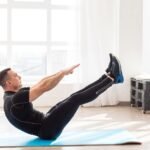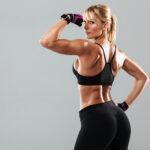Bent-Over Dumbbell Tricep Kickback: Exercise Overview
The bent-over dumbbell tricep kickback is a time-tested isolation exercise designed to target the triceps brachii, emphasizing all three heads (long, lateral, and medial) to enhance arm size and definition. This movement focuses on controlled contractions to build a strong mind-muscle connection, making it a staple in hypertrophy-focused training.
Ideal as a finisher in arm workouts or to complement pressing movements, the bent-over dumbbell tricep kickback is a versatile addition to tricep-focused sessions, upper-body routines, push workouts, or full-body programs. It’s particularly effective for lifters seeking aesthetic arm development and improved tricep strength (Schoenfeld, 2010).
How to Perform the Bent-Over Dumbbell Tricep Kickback
- Select an appropriate pair of dumbbells and stand with feet hip-width apart in an open area.
- Hinge at your hips, keeping a slight bend in your knees, and row the dumbbells to your sides with elbows bent at about 90 degrees, maintaining a neutral spine—this is your starting position.
- Extend your elbows to push the dumbbells backward, flexing your triceps fully while keeping your upper arms parallel to the ground.
- Pause briefly at the top, squeezing your triceps for maximum contraction.
- Slowly lower the dumbbells back to the starting position, maintaining control and tension in the triceps.
- Repeat for the desired number of repetitions.
Tips for Optimal Performance
- Focus on Controlled Movement: Perform the extension and descent slowly to maximize tricep activation and enhance the mind-muscle connection, avoiding momentum (Schoenfeld, 2016).
- Maintain a Neutral Spine: Hinge at the hips and engage your core to prevent excessive lumbar curvature, reducing lower-back strain (McGill, 2010).
- Keep Upper Arms Stable: Ensure your upper arms remain parallel to the ground and elbows fixed to isolate the triceps effectively (Wirth et al., 2016).
- Avoid Overextension: Keep your head in a neutral position, focusing on a spot on the floor to avoid neck strain and maintain proper posture.
- Breathe Properly: Exhale as you extend the dumbbells backward and inhale as you return to the starting position to support core stability and muscle oxygenation.
- Choose Appropriate Weight: Select dumbbells that allow controlled form for your target rep range (e.g., 10–15 reps for hypertrophy) to avoid swinging or compensatory movements.
Sculpting triceps with kickbacks? See how they enhance arm strength in our Ultimate Guide to Muscle Groups.







